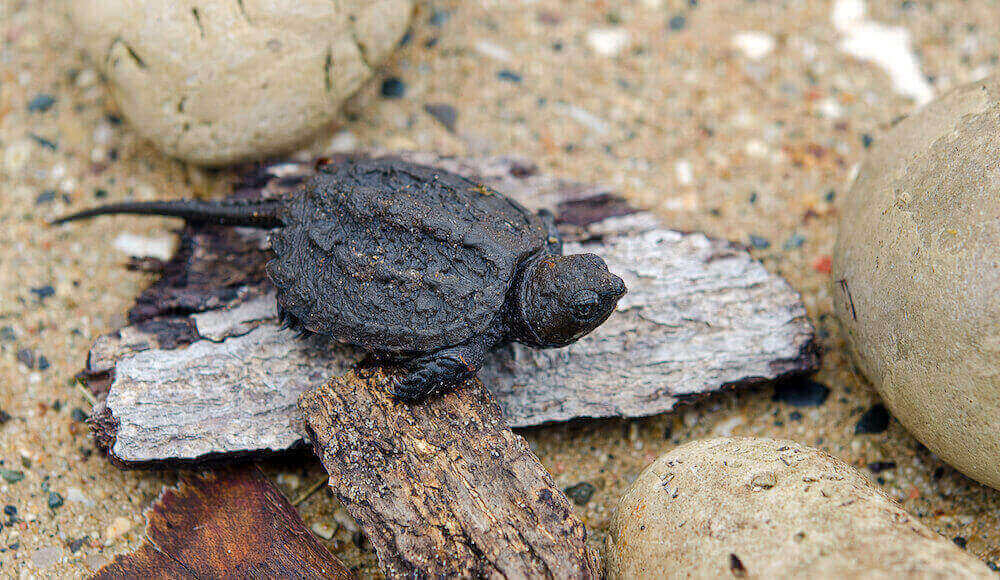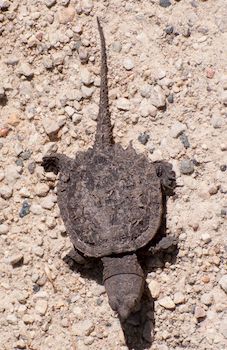
Baby snapping turtles are part of the Chelydridae family, also known as the snapping turtle family. It only has two types: the common snapping turtle (Chelydra serpentine) and the alligator snapping turtle (Machrochelys Temminckii).
The common snapping turtle can be found commonly throughout North, Central, and South America. Meanwhile, the alligator snapping turtles are considered endangered species and can only be found in the southeastern part of America. Most states also protect alligator snapping turtles. Keeping one, if desired, requires obtaining a special license declaring that it is for educational purposes that will prove beneficial to the animal and ensure its protection.
Common snapping turtles can grow typically up to weigh 25 to 35 lbs and live up to 60 years, while the alligator snapping turtle weighs up over to 100 pounds and can live well over 150 years.
Snapping turtles are hardy creatures and can tolerate any harsh environment and will be suited comfortably in captivity.
Snapping turtles, from its namesake, are famously known for its action–snapping. Despite being a ‘turtle’, primarily referring to common snapping turtles, they are carnivorous and predatory animals. They can quickly dart over to the subject underwater, and with their ability to elongate their necks, they would snap their prey in a blink of an eye. Meanwhile, alligator snapping turtles are more of a waiting-and-baiting carnivore, luring their prey with their open mouths and then quickly snapping their beak-like jaws shut.
For humans who can be careless in handling snapping turtles, be careful to where you grab their shells since their neck can stretch to the back of their shells. If they feel threatened, they will let out a hiss first before snapping.
Appearance

We’ll first discuss the common snapping turtles. These have oval-shaped carapaces, a term for their shells. Hatchlings would have a more rounded shell with lines running along the back. At a young age, the shell would have a rough texture that will eventually smoothen as the turtle ages. Hatchlings start at the length of 1 inch and wideness of 1 inch with their tails sticking out at about 1-1.5 inches long. Carapaces can differ in color ranging from brown, tan, grey, and black. The bottom of the shells called the plastron, but for hatchlings, these are colored black.
The leathery skin of snapping turtles can vary in color–grey, yellow, black, or tan and may come with patterns like white flecks. The head will be particularly darker in color compared to the neck, legs, and tail, which have a yellowish hue.
Their tails are exceptionally long, which is at about the same length as the carapace, and you’ll be able to notice thorns sticking out as saw-teeth, those are called keels.
The common snapping turtle has a unique mechanism to stretch and crane their necks to reach their prey. It is also quite useful when living out in shallow muddy banks or marshes where they would sleep underwater, and they would simply stretch out their necks to get some air and sleep again.

If you have snapping turtle as a pet or seeing a stray snapping turtle on the road, ABSOLUTELY DO NOT HANDLE THEM BY THE TAIL. Since its tail is connected directly to the spines, handling this sensitive part could hurt them, resulting in an untimely death.
It would be better to lift the turtle with its shell, placing your hands close to its back legs so it won’t reach your hands.
Size
As mentioned above, hatchlings can be 2-3 inches in length, making them quite adorable and attractive to enthusiasts. Due to their size, they are suitable for small tanks such as a 10-gallon water tank, still giving it plenty of space to swim, walk and dig around.
As they grow, they need to adjust to bigger tanks is a must, and here is where the challenge lies for most owners. Due to the lack of space for movement, they can often be destructive and stressed since they are not used to their surroundings or the wrong environment.
Common snapping turtles can grow up to 18-20 inches and weigh for up to 75 lbs, and as mentioned above, average common snapping turtles only weigh up about 35 pounds.
In addition to this, males are bigger and weigh more massive than females.
Behavior
Snapping turtles love being underwater, so reestablishing this kind of set up in the tank will make them more comfortable and adjust faster. They also like to burrow in the sand or run wherein they will bury themselves, covering everything except for the nose and eyes while waiting for unsuspecting prey.
Baby snapping turtles can be the most adorable creatures you have had as a pet, though looks can be deceiving. They are not called snapping turtles for no reason. As hatchlings, their bites may not be much, but once they have grown up to the size of your hand, their bite would start to get some force into them. As they grow into adults, those powerful jaws can remove a finger or toe bearing the force of 209 newtons, which is an astounding 45 lbs. of force.
Usually, snapping turtles venture alone in the wild. If you’re thinking of having the two of them, it may not be a good idea since they are most likely going to argue and fight each other, by which they can potentially kill one the other.
Food Diet
Snapping turtles are known to be omnivores, and their food is one of the most crucial concerns in taking care of them. There is a matter of knowing the right amount of food. Careful not to overfeed or underfeed the snapping turtle. There is the main sign if it is overfed: you’ll notice that its skin looks like its unfolding from the shell. While you’ll see this sign if it is underfed: when it goes into the shell, you can barely see its head.
Since they are omnivores, their diet can consist of vegetarian matters as well as small animals such as small rodents, small fish, insects, and turtle pellets.
They are known to be agile hunters and voracious eaters out in the wild, preying on small reptiles and amphibians such as frogs, snails, even smaller turtles, pollywogs and newts. They eat a variety of things such as fish, invertebrates, as well as small mammals like ducklings, small birds, and goslings.
But upon captivity, the plant-based matter will be a part of their diet composed of leftover fruits and vegetables and some aquatic plants. As much as possible, avoid getting food from the wild primarily when your turtle is a pet since food from outside can contain unknown pathogens, which will affect your snapping turtle’s health.
Putting some plants on the tank will be beneficial since they’ll snack on these and keep them healthy and fresh. Plants like Scindapsus or Monstera, flakes, or other leafy food can rotate to add variety to its menu.
For artificial food, choose the granules and flakes that are right for your turtle’s diet to suit its nutritional needs. Granules especially contain the necessary nutrients for them.
Remember that the amount of food will increase and change as they grow and age. Baby snapping turtles like bloodworms, unfrozen pieces of fish, shrimps, and others, then alternate this by feeding them plant-based matters like fruits as snacks.
Maintaining your tank is the same as having regular fish since they are messy creatures. Be sure to clean the tank and replace the filter foam to wring out the dirt built up and maintain the excellent condition of the water. Here’s a tip to ease the chore of cleaning after them: have a separate tank or container, smaller in size for their feeding time so that it’ll be easier to clean.
Hatchlings should be fed one to two times per day, and adult snapping turtles every other day or three times a week.
1) What to Avoid
Though, snapping turtles aren’t finicky about their food and would pretty much eat up anything that has been offered to them, here is a list of don’t that you should never let your snapping turtle have:
a) dairy products
b) any kind of sweet (such as Candy, chocolate and refined sugar)
c) canned or processed food (has preservatives and high sodium content)
d) anything and even relatives of onion and garlic
e) rhubarb, avocado and all fruit seeds
What if a Baby Snapping Turtle Won’t Eat?
Two possibilities may cause and affect your snapping turtle from eating. Concerns like this often occur among pet owners even if they are not snapping turtles, so there is no need to panic. However, in such a worrying state, the owner should recognize the reason that is causing its lack or even loss of appetite. It should not be ignored since the snapping turtle will end up starving itself when it could have been acted upon immediately.
1) Water Temperature and Environment
Despite its high tolerance and resilience in hardy environments, snapping turtles are sensitive towards the water temperature and if something is bothering them in their current surroundings.
Check the water condition of the tank. They might just refuse to eat in filthy water. Check the temperature, since this is one of the main factors for this creature to lose interest especially when it is too cold for them. Turtles are reptiles, cold-blooded creatures, so heat is essential for them. Cold temperatures put them in an almost hibernate state, making them feel sluggish and sleepy than being in their usual active nature. Make adjustments as soon as you’ve determined the cause.
2) Recognizing Signs of Illness
The baby snapping turtle may have caught an illness and thereby rejecting the food that they would usually love to have. Stress also causes illness, so determining what’s causing their stress would make them feel better in no time. If it’s an illness, try to determine it since it could be constipation, vitamin a deficiency, eye problems, respiratory infections, or even pregnancy.
Conclusion
Baby snapping turtles are rated as easy to take care of. In terms of food, they are one of the most voracious of eaters, they are fun to have around and they are adorable.
But despite it being low maintenance, make sure that it has a balanced diet with a variety of food that is right for it to stay healthy and active. Make sure not to overfeed or underfeed your pet since these could lead to health problems.
Be observant of its activities and habits as they may change and indicate problems from its onset especially the state and condition of your tank. Maintaining its cleanliness would mean a lot for the snapping turtle.
Adjustments and care must be made as they grow older and into adults as their behavior and looks change. The tank size will be considerably bigger, they may be moodier and potentially destructive if they don’t like the food.
Adult snapping turtles according to experienced keepers are challenging, so much thought should be put into keeping a baby snapping turtle. Just because it looks sweet and cute as a baby, doesn’t mean that once it gets into a difficult stage, you’ll release it into the wild which is one of the big no-no’s in being an animal keeper.








